There's an old joke that goes something like this:
Healthy Person: How do you cook a boneless, skinless chicken breast but actually make it taste good; you know, like not dry?
Chef: Well, first you start with about two pounds of butter...
While I make no claims that this is a "healthy recipe," it is no doubt one of the best ways to prep and cook a boneless, skinless chicken breast. This is due in large part to brining the breast and then pounding it out, which inherently will make it more tender.
To make the brine mixture, weigh out enough cold water to completely cover the amount of chicken breasts you plan on turning into roulades. Multiply the weight of the water by .05 (5%) and add that amount in salt, whisking to dissolve. For example, if the water weight is 1000g, your equation would look like this: 1,000g X .05 = 50g Salt.
Brine chicken breasts overnight in refrigerator; 12 hours is good, 24 is better. Remove chicken breast from brine, rinse under cold running water and pat dry with paper towels.
Using a sharp knife, slit the sides of a gallon zip top bag as shown in the photos below. Lightly moisten the chicken breast with cold water to keep it from sticking to the bag and place breast inside the bag, skin side down.
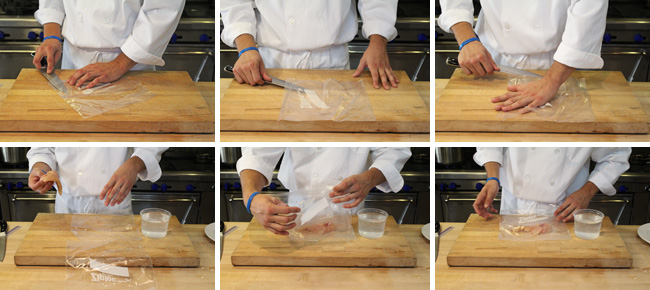
Using glancing blows, pound the thickest portion of the chicken breast with the textured side of a meat mallet until it starts to break down and flatten. As the breast becomes thinner, flip the meat mallet over and use the non-textured side to "fine tune" the breast, pounding it as thin and wide as possible without actually tearing the flesh.
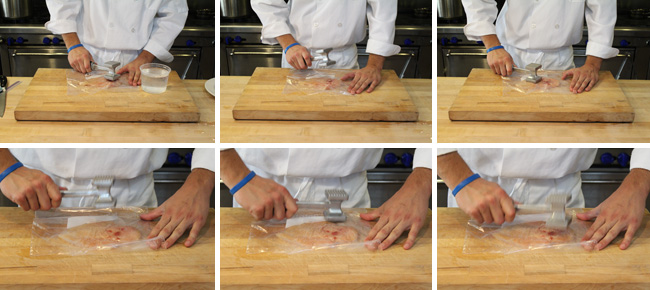
Place the pounded chicken breast skin side down on top of a long sheet of plastic wrap and inlay your filling of choice; here we're using provolone, prosciutto di parma and caramelized onions.
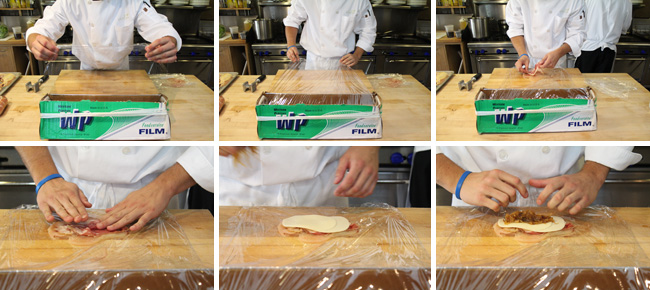
Roll pounded chicken breast around your roulade filling, and then tightly wrap in plastic wrap.
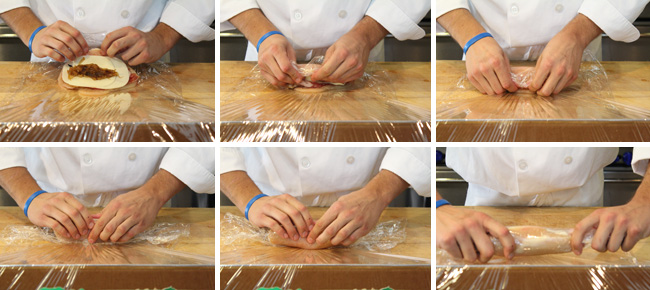
Grab ends of plastic wrap as shown in photos below, and use a counter twisting motion to form the roulade into a tight cylinder. Once the cylinder forms, roll the roulade on your work surface, pushing it away from you in rapid motions, while still holding the plastic wrap ends. Repeat this motion a few times until the plastic wrap builds tension and the roulade is noticeably tight.
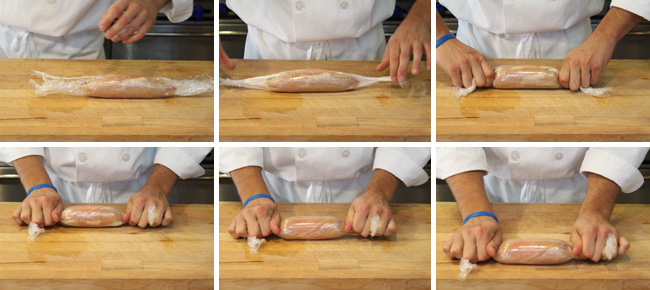
Tie off both ends while taking care to not release any tension created in the previous step.
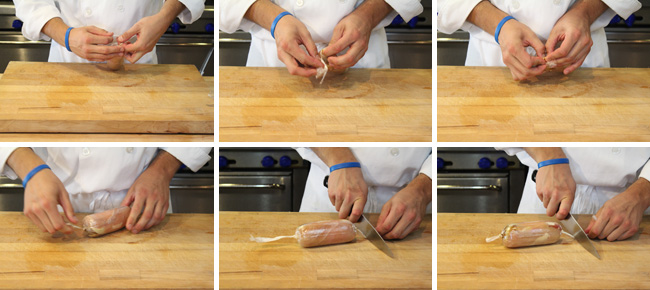
Poach in water that is just below a simmer (180ºF/82ºC) for 18-20 minutes. Remove from poaching liquid and chill in an ice bath.

These roulades can be served either hot or cold, but are best if first chilled and then reheated with a secondary cooking process. Currently at Stella we will prep, poach and chill the roulades before service and then tempura fry to give a crisp outer coating while bringing back the core temperature. The tempura batter also has the added benefit of keeping the cheese and other fillings from melting out during the reheating process.
Related Resources
There are 11 Comments

For this particular
For this particular application, I prefer to extend the brine time which effects the texture and makes it more dense. The chicken meat itself will be at the higher end of "seasoned" with the salt being somewhat perceptible, but I find it pleasant, especially when properly balanced with the other ingredients in the end dish. This is also why in the Completed Dish of this roulade, I used a very light hand when seasoning the other components.
You can brine for less time with great results; in this application, it just comes down to personal preferance.
Thanks for this Technique
Hi Chef Burton,
I was able to successfully pull off this technique. I see many uses for this. By the way, I stuffed mine with fresh basil, fresh cumin, some feta cheese, thinly sliced radish and caramelized onion. I then simply roasted it with a lemon, butter, oil and served the rounds with a dollop of Toum (garlic sauce) and drizzled some aged balsamic.
Thanks again for sharing these techniques.

Awesome! I always love when
Awesome! I always love when people can see the technique for what it is and make it their own. Your preparation sounds delicious. This also works good for a butterflied pork tenderloin and other, similar cuts.

Hey Todd, Yep, the link was
Hey Todd,
Yep, the link was broken but I just fixed it. Here it is: http://stellaculinary.com/podcasts/video/chicken-roulade-sauted-summer-s...
Thanks for the heads up.

Hey there primalcupcakes,
Hey there primalcupcakes, welcome to Stella Culinary!
Did you cook the roulade yet? How'd it turn out?

Hi ljenis, You can serve the
Hi ljenis,
You can serve the roulade unbreaded. You will need to add some sort of textural component to the dish however, but that shouldn't be an issue.
Did you have something specific in mind?
